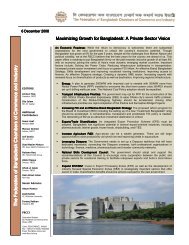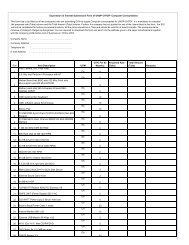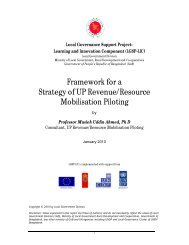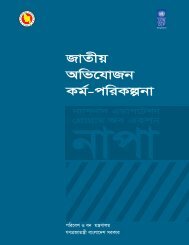The probable impacts of climate change on poverty - UNDP
The probable impacts of climate change on poverty - UNDP
The probable impacts of climate change on poverty - UNDP
You also want an ePaper? Increase the reach of your titles
YUMPU automatically turns print PDFs into web optimized ePapers that Google loves.
5.3 Changes in Sea Level and Salinity Intrusi<strong>on</strong><br />
Change in the sea level at local level depends <strong>on</strong> several factors and therefore future sea level rise projected in<br />
the assessment report <str<strong>on</strong>g>of</str<strong>on</strong>g> the Intergovernmental Panel <strong>on</strong> Climate Change (IPCC) will not be uniform all over<br />
world. One <str<strong>on</strong>g>of</str<strong>on</strong>g> the critical factors related to Bangladesh coast is vertical land movement (subsidence/uplift).<br />
Seas<strong>on</strong>al variati<strong>on</strong> <str<strong>on</strong>g>of</str<strong>on</strong>g> salinity intrusi<strong>on</strong> also depends <strong>on</strong> freshwater flow in the river system and cycl<strong>on</strong>ic storm<br />
surges.<br />
<str<strong>on</strong>g>The</str<strong>on</strong>g> SAARC Meteorological Research Council (SMRC) carried out a study <strong>on</strong> recent relative sea level rise in the<br />
Bangladesh coast. <str<strong>on</strong>g>The</str<strong>on</strong>g> study has used 22 years historical tidal data <str<strong>on</strong>g>of</str<strong>on</strong>g> the three coastal stati<strong>on</strong>s. <str<strong>on</strong>g>The</str<strong>on</strong>g> study<br />
revealed that the rate <str<strong>on</strong>g>of</str<strong>on</strong>g> sea level rise during the last 22 years is many fold higher than the mean rate <str<strong>on</strong>g>of</str<strong>on</strong>g> global<br />
sea level rise over 100 years, which showed the important effect <str<strong>on</strong>g>of</str<strong>on</strong>g> the regi<strong>on</strong>al tect<strong>on</strong>ic subsidence. Variati<strong>on</strong><br />
am<strong>on</strong>g the stati<strong>on</strong>s was also found. Table 5.3 represents the trend <str<strong>on</strong>g>of</str<strong>on</strong>g> tidal level in three costal stati<strong>on</strong>s.<br />
Table 5.3 Trend <str<strong>on</strong>g>of</str<strong>on</strong>g> tidal surge in three coastal stati<strong>on</strong>s<br />
Tidal Stati<strong>on</strong> Regi<strong>on</strong> Latitude (N) L<strong>on</strong>gitude (E) Datum (m) Trend (mm/year)<br />
Hir<strong>on</strong> Point Western 21 3.784<br />
˚48’ 89˚28’ Char Changa Central 22 ˚ 08’<br />
Cox’s Bazar Eastern<br />
Source: SMRC, No. 3<br />
A2<br />
(High Emissi<strong>on</strong> Scenario)<br />
High<br />
Low<br />
B1<br />
(High Emissi<strong>on</strong> Scenario)<br />
High<br />
Low<br />
21 ˚ 26’ 91 ˚ 59’<br />
<str<strong>on</strong>g>The</str<strong>on</strong>g> Probable Impacts <str<strong>on</strong>g>of</str<strong>on</strong>g> Climate Change <strong>on</strong> Poverty and Ec<strong>on</strong>omic Growth and<br />
the Opti<strong>on</strong>s <str<strong>on</strong>g>of</str<strong>on</strong>g> Coping with adverse Effect <str<strong>on</strong>g>of</str<strong>on</strong>g> Climate Change in Bangladesh<br />
4.0<br />
91 4.996<br />
˚06’ 6.0<br />
Sea Level Rise (cm)<br />
2020 2050 2080<br />
6 27 62<br />
- 5 9<br />
5 23 48<br />
- 8 15<br />
4.836 7.8<br />
<str<strong>on</strong>g>The</str<strong>on</strong>g> IPCC 3rd Assessment report estimated that the global rise in sea level from 1990 to 2100 would be between 9<br />
and 88 cm. <str<strong>on</strong>g>The</str<strong>on</strong>g> Third Assessment Report has also projected global sea level rise for the year 2020, 2050 and 2080<br />
using different emissi<strong>on</strong> scenarios. Future projecti<strong>on</strong> <str<strong>on</strong>g>of</str<strong>on</strong>g> Global Sea Level Rise is given below.<br />
Table 5.4 Sea Level Change under different Emissi<strong>on</strong> Scenarios<br />
Recent study result revealed that about 13% more area (469,000 ha) will be inundated in m<strong>on</strong>so<strong>on</strong> due to 62 cm<br />
sea level rise for high emissi<strong>on</strong> scenario A2 in additi<strong>on</strong> to the inundated area in base c<strong>on</strong>diti<strong>on</strong>. <str<strong>on</strong>g>The</str<strong>on</strong>g> most<br />
vulnerable areas are the areas without polders like Patuakhali, Pirojpur, Barisal, Jhalakati, Bagerhat, Narail. Due to<br />
increased rainfall in additi<strong>on</strong> to 62cm sea level rise, the inundated area will be increased and about 16% (551,500<br />
ha) more area will be inundated in the year 2080. On the c<strong>on</strong>trary, in the dry seas<strong>on</strong> due to 62cm sea level rise<br />
about 364,200 ha (10%) more area will be inundated (inundati<strong>on</strong> more than 30cm) for A2 scenario in the year<br />
2080. However, 15cm sea level rise has insignificant impact <strong>on</strong> inundati<strong>on</strong> in dry seas<strong>on</strong>.<br />
It is important to note that analyzing the <str<strong>on</strong>g>impacts</str<strong>on</strong>g> <str<strong>on</strong>g>of</str<strong>on</strong>g> sea level rise in the coastal areas need to incorporate<br />
dynamic nature <str<strong>on</strong>g>of</str<strong>on</strong>g> its morphology and formati<strong>on</strong> process. Bangladesh is a dynamic delta and its landmass is still<br />
growing by gradual depositi<strong>on</strong> <str<strong>on</strong>g>of</str<strong>on</strong>g> sediment. <str<strong>on</strong>g>The</str<strong>on</strong>g> average sediment accumulati<strong>on</strong> rate for the last few hundred<br />
29










